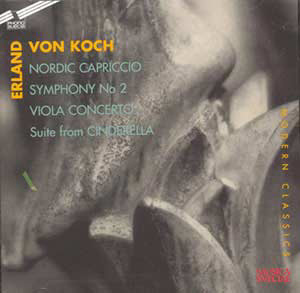"Von
Koch’s affectionate attitude towards his music is reflected in
the spontaneous brightly singing melodies. He really sings when
he has something to say which he frequently has." Gösta Nystroem
described Von Koch's Third Symphony in these terms in 1947.
Erland
Von Koch's Nordiskt Capriccio is a rumbustious fantasy
overture in which rhythmic interest and folklike melody redolent
of the fresh outdoors adds up to a mercurial though none too reflective
concert livener. It has counterparts in Copland's Outdoor Overture
and, more closely, Moeran's Overture to a Masque. The
music is familiar from the Swedish Society LP (SLT33136) of the
Nystroem Sinfonia Concertante for cello and orchestra.
It was the comparatively slight filler on that album. It is good
to hear it without the spalling and blemishes so familiar from
my black disc version.
It
prepares the ground for the Sinfonia Dalecarlica.
After an angular first movement with an optimistic and aspirational
Scandinavian melody comes a purposeful outdoors scherzo and a
magical andante espressivo in which solo instruments call
across the lonely landscape. Jan Lennart Höglund's notes
refer to those quiet summonsings as herding calls. The finale
has the pause and press-forward rapture of a Vaughan Williams
folk-scherzo rather like one of the Norfolk Rhapsodies or
Holst's Somerset Rhapsody. But this rum-ti-tum jollity
is diluted by the aspiration and melancholia of the previous movements.
The
Viola Concerto dates from 1946 and is more ambivalent in
mood. It is the first of his numerous concertos. The others are
for wind instruments (six), piano (three), and one each for guitar,
cello, and one double (violin and piano - potentially a nice coupling
for Martinů's masterly double for the same instruments.).
The concerto is in three movements and despite disclaimers in
the booklet notes (by Jan Lennart Höglund) the caste of the
music is poignantly folk-pastoral. The music gravitates towards
song and this is at its most evident in the Presto where
at 4.40 a cantilena floats free from the insistent catch-as-catch-can
chasse. An overlay coloured by triumph - resin and rosin - pervades
the allegro non troppo finale celebrating play and work.
This is not like Vaughan Williams but it will work alongside Flos
Campi and the Suite and the Stanley Bate Viola Concerto.
At 1.40 somewhat unnervingly there is a shadow of the finale of
the Korngold Violin Concerto. This is music that has a glint in
its eye and an eagerness that should carry it far.
Between
1945 and 1953 Von Koch turned out the music to sixty or more films.
There are six by Ingmar Bergman in that list so keep your eyes
open for the next Bergman season on your terrestrial, cable or
satellite artfilm channel. Continuing the incidental music line
the disc offers a three movement suite from Von Koch's music for
the 1942 ballet Cinderella. Rather like Rosenberg's
The Last Judgement Von Koch never got to see his ballet
produced; Cinderella was cancelled due to the designer's
bizarre ideas. The three movements include a jumpy Prokofiev-like
march, a prize-winning Nocturne influenced by the gentlest
wisps of ideas from Ravel and a crashingly confident Vals.
The
disc is handsomely presented and documented and the picture is
rounded out with a photograph of the composer staring out at dusk
across the waters of Lake Siljan in 1946 - the year of the Viola
Concerto.
The
advocacy of everyone involved is convincing and full of conviction.
I thought Johanna Persson's playing of the Viola Concerto especially
strong..
Rob
Barnett
